Riding the length of Portugal from Valenca to Tavira
Our ride from Valenca to Tavira followed on from our completion of the Camino de Santiago from Santander to Santiago de Compostella in Galica, Spain.
The ride out of Santiago had been through unremarkable countryside and towns. The last day in Spain was a nice ride, but ended at the town of a Caniza just prior to the Spain - Portugal border. From their we crossed the Minho river and headed due West, following the river to the town of Moncau and on to Valenca.
The town stands in a strategic position high above the wide Minho river, commanding a magnificent view across the Moho to Spanish territory. It was from here that we commenced our ride South, through Porto, Lisbon and then heading East and South to Tavira on the Algarve coast just 30km West of the Spanish border.
Schedule
Our ride descriptions give an account of the ride that we completed. As part of the description we also provide links to Wikiloc or Google maps and elevation profiles based on mapping data available through the internet. The ride profiles are smoothed to give what in our opinion is a more beneficial view of the profile. We use paper maps, GPS and on line data to plan and conduct our rides. We are happy for you to use our descriptions, but be aware that we do not guarantee the accuracy of the information provided as situations surrounding any ride change over time.
Valenca to Tavira - Day 1 - Valenca to Ponte de Lima
- Distance 39.9 km
- Max Elevation 350m

Valenca to Tavira - Valenca to Ponte de Lima Ride Profile
Ride Description
Before starting our Valenca to Tavira ride we climbed up the cobbled streets into the old citadel with the most impressive city walls and fortifications.
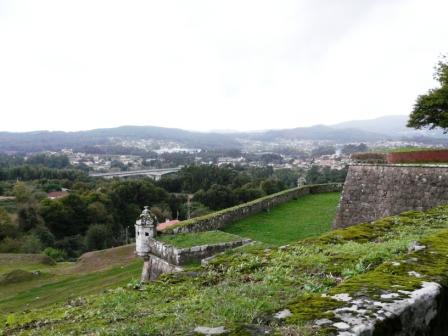
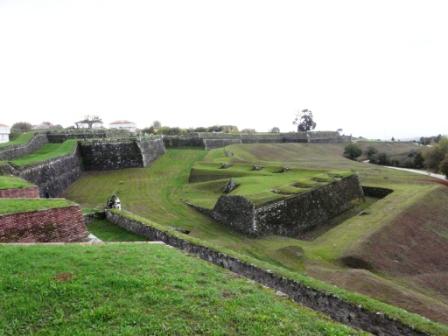
In the town were many old traditional Portuguese buildings with wrought iron balconies and blue and white exterior tiled facades. We had the obligatory visit to sample the coffee and cake, walked around the walls and then got back on our trusty steeds to cycle out of the town, stopping to buy lunch on the way and the start of our Valenca to Tavira ride.
Our Valenca to Tavira route took the back roads out of Valenca to avoid the main roads, which were a lot less developed than those of Spain. It made us realize just how good Spain's roads and signage are. After a short while signs disappeared or were to just local places that weren't even on our map or to "autre directions" that seemed to encompass anywhere else. We managed to find our way through the maze of back roads onto the old main road, which wasn't too busy as the new motorway took most of the traffic.
The climb was pretty gradual through many different villages. On the way up we passed an old man with a hand cart full of big rocks. He must have been in his eighties at least and could hardly walk unaided, but he was determined to push this cart up the hill and one of the wheels was almost falling off. If we hadn't been intent on getting to our destination before dark, we would have stopped to help, but we had no doubt that he would succeed as he clearly was used to hard work.
Finally our Valenca to Tavira route crossed over the motorway at the watershed. The Valenca to Tavira ride down was, to start with through a lovely wooded hillside, but as we approached half way, we came to a massive granite quarry. All down the road for several kilometers were small independent businesses making objects from granite purchased direct from the quarry. These objects ranged from simple paving stones through to ornate religious statues and edifices. The quarry stretched for kilometers and it seemed like they were ripping the whole side of the mountain apart.
As we rode further down towards the Lima river, the traffic got busier and the final part of the journey to Ponte de Lima was unpleasant and the place itself didn't seem very nice.
Until that is, we rode into the old town which straddled the wide Lima river. Most of the town was on the south side and had an old historic center where the old castle keep was situated overlooking the river. From there the old multi-arched bridge stretched across the river to the north bank, where the Albergue de Perigrinos was situated.
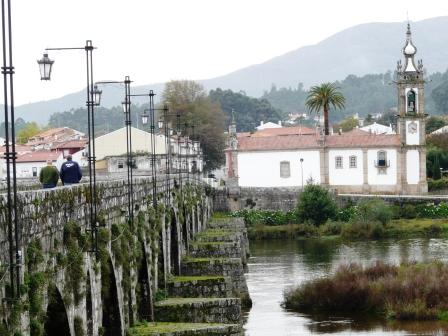
The Albergue was the best we had stayed in, being modern, clean and the staff were all really friendly.
The town has a long history going back to before Roman times. Legend has it that the waters of the river were magical and anyone who crossed it would lose their memory of their home and family. When the advancing Roman army arrived at the river, the troops refused to cross because of this superstition.
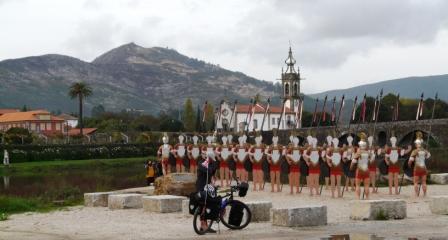
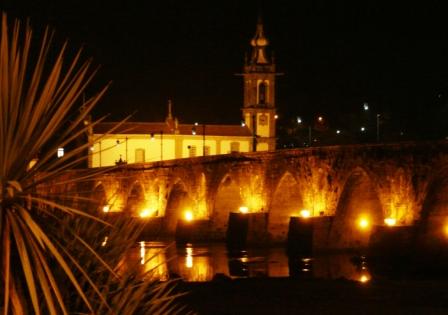
The Roman general had to cross first and call out the names of all his generals to prove to his troops that it was safe to cross. This scene features in the town's history, with re-enactments of the event and a permanent, but tacky model of the general and his army on either side of the river.
At night the bridge is lit up giving a different look.
We asked the advice of the Albergue staff where to eat, but the place they recommended was shut. We searched around and it being Monday night, most places were closed. We finally found a little street bar / café overlooking the river. There was just one little old lady running it and no other customers. The choice was soup or soup to start and meat or fish for main. We chose soup and meat with house red wine. It was a delicious home-made meal of braised beef, fries and fried rice. Strange combination, but it was just what we needed.
Valenca to Tavira - Day 2 - Ponte do Lima to Guimaraes
- Distance 65.2km
- Max Elevation 530m
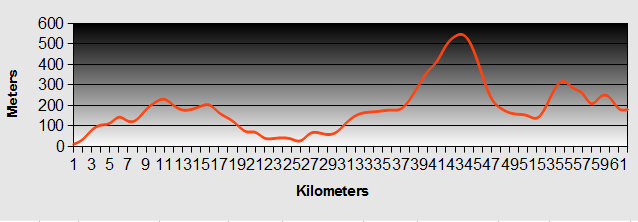
Valenca to Tavira - Ponte do Lima to Guimaraes Ride Profile
Ride Description
It was a fairly cold morning so we had cycling tights and fleece tops on for today's leg of our Valenca to Tavira ride. Shortly out of town we stopped to buy provisions and then continued on the long drag hill, along the main road which was busy with heavy lorries and cars. Although there was a motorway running parallel, it seemed that nobody wanted to pay the toll fees.
Our Valenca to Tavira route along this stretch of road seemed to go on and on, so it was head down to cover the 33 kilometers to Braga, which was to be our lunch time stopover. Braga is a large city, which initially seemed like just a big urban and industrial sprawl. We asked some students how to get to the old town and were directed "up and up and up the hill". It was a steep climb and as we came to the old town we stopped at the first bit of park we came to and got out the picnic. The usual strange looks accompanied it.
We had a look around Braga old town and shopping area, purchased a Portuguese SIM card, visited tourist information and set off out of town to visit Bom Jesus, which we had read about in the "RoughGuide". It was a hard climb up several hair pin bends, but well worth the effort.
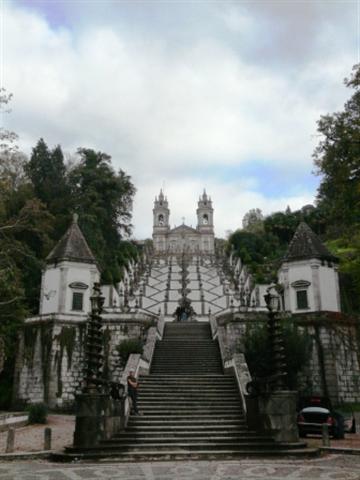
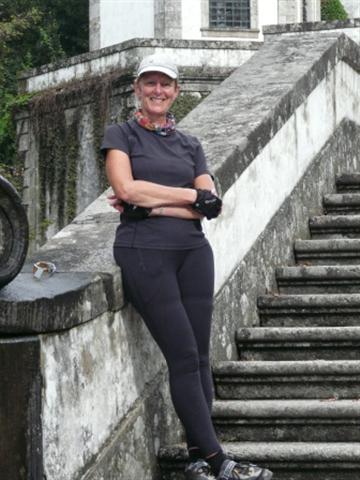
Bom Jesus is one of Portugal's most famous images. It was commissioned by Archbishop Maura-Teles in 1723 and took 60 years to complete. It comprises a church at the top of a series of ornate granite stairways and fountains down the hill side and standing out from the forest around it. It is an extremely popular tourist attraction, but as it was November there was hardly anyone else there, except for this rather attractive, well bodied babe.
From there we carried on up the hill, stopped at the top for a coffee and on towards Citania de Briteiros. This is Portugal's most ancient and best preserved sites of celtic village remains. We were really pleased that we took the time visit the site.
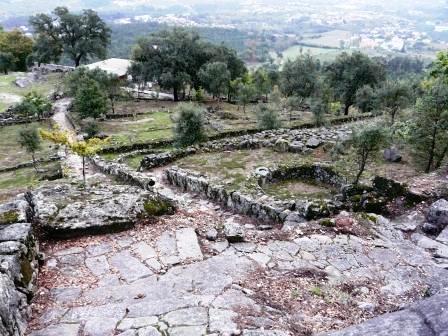
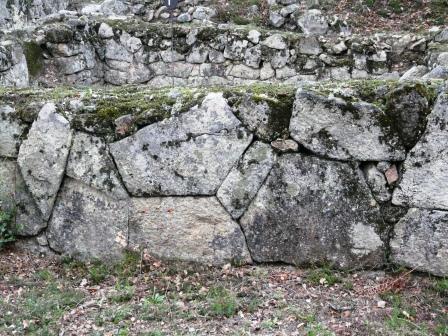
It is quite amazing to realize that these early villagers were very sophisticated in their organization and architecture.
The pictures show how well built the walls were, every stone being carefully fitted to its neighbour.
There was a complex network of water channels running throughout the village and a communal bath house with steam room and cold water bathing area, (the aluminium channel of course is not part of the original).
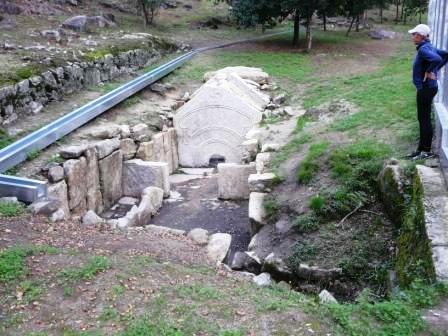
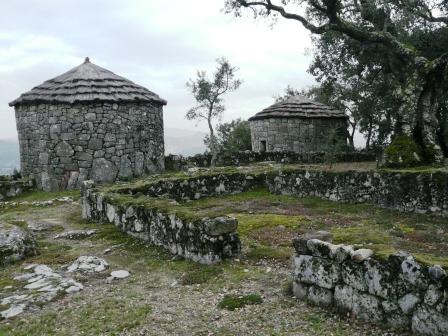
The reconstructed houses seen on the site really did not fully represent what it must have really been like.
The caretaker of the site was also a keen cyclist and was very interested in our bikes and our ride from Valenca to Tavira. He treated us to a coffee before we left the visitor center and also helped us out with Valenca to Tavira route finding to our nights stop. However, we had left it too late and we knew that we would be completing our Valenca to Tavira ride in the dark.
This part of our Valenca to Tavira ride, the road to Guimaraes was very busy and narrow in places with nose to tail traffic in both directions. We stopped to put on our fluorescent jackets and switch on our lights, but we still felt very nervous as Portuguese drivers are not as tolerant as their Spanish counterparts. The final part of the Valenca to Tavira ride was a 1st gear climb up under the busy motorway into the town. It was awful and by the time we got to the square in the old town we were both very tired, fed up and short on temper. We gathered our wits, ate a banana and found the Pousada de Juventude (Youth Hostel). The term "Youth Hostel" didn't do it justice it was better than some hotels that we had stayed in. We booked in for one night, but followed that with a second night as we just needed a day off to dry our gear properly, do our washing and do some admin. Oh and of course to do some sight seeing and enjoy the local fare.
Guimaraes was the original Portuguese capital and has a lovely old centre and an impressive castle that has been largely rebuilt from its previous ruinous state. At one point in its history, the castle was only just saved from being torn down so that the stone could be used to pave the streets.
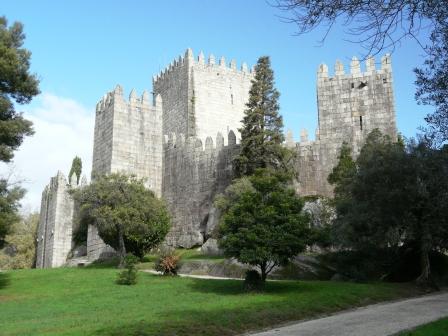
Valenca to Tavira - Day 3 - Guimaraes to Porto
- Distance 103km
- Max Elevation 260m

Valenca to Tavira - Guimaraes to Porto Ride Profile
Ride Description
We woke to on and off rain. We packed and ate breakfast in the hostel and planned our Valenca to Tavira route and departure from the town. Following Tuesday's awful entry into the city we wanted to find less busy roads for our way out on our Valenca to Tavira ride. We took the N105 in a south westerly direction, which we would follow due west to the coast and then down the coast into Porto, avoiding the main roads. We now realise that the strip of land some 80km wide down the western side of Portugal is densely populated and industrial and as a consequence has a lot of traffic. They all seem intent on being the next F1 champion and have little regard for anything like a highway code, let alone bikes. Unlike the Spanish roads, most of the Portuguese roads don't have a nice wide hard shoulder that can be requisitioned by cyclists.
Our Valenca to Tavira route took us along a road that was busy all the way until we got nearer to the coast, but even then on the back roads there was a lot of traffic. To make things worse the back roads down the coast (for 15km) were all cobbled making the riding very uncomfortable and slow. The beaches were impressive with massive Atlantic rollers breaking over the rocks and onto the sandy beaches, but the towns were rundown and unattractive.
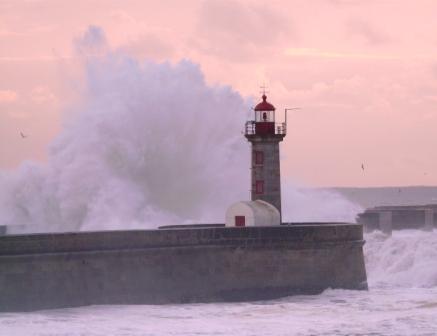
Our Valenca to Tavira route continued along the river. By now it was dark and raining (again). It was a struggle to read the map and navigate our way through the one way system and up steep cobbled streets. However, we did manage to find the Pension that was recommended in the RoughGuide which turned out to be clean, reasonably priced and with English speaking staff.
We checked in, exhausted, but quickly showered and went out for a meal in a traditional Portuguese eating house.
The following morning (Friday) it was pouring with rain. Our shoes that we had left on the balcony (because of the smell) were soaking wet. We snuggled under the duvet and didn't want to get up. We decided that we needed to take a few days in Porto and decide what we were going to do over Christmas and therefore our Valenca to Tavira travel plans for the next few days.
Our room was already booked by someone else for Friday night so we had to find an alternative. The tourist office told of some apartments let out by the Hotel America. They sounded expensive at 50-60 euros, but we went to see the owner and negotiated 40 euros for what turned out to be a very nice apartment.
It was nice to walk around the old market in the next street and buy fish, meat and proper vegetables for the next three days and think about cooking some of our own food again. As there was no internet we spent the afternoon finding a suitable internet café to complete our blog.
The apartment that we found was on rua St. Catarina, one of the main shopping streets in the town. It was on the first floor, overlooking the street which allowed us to watch the action in the street. While we were there we had a South American Andean band playing its haunting flute and drum music, a young mime artist and clown making balloon sculpture for the children and the many sellers of lottery tickets and roasted chestnuts filling the street with smoke.
More disturbing than this was the large number of beggars and homeless people, many of whom were disabled. There was the old couple selling lottery tickets by day and at nights sleeping in a shop doorway. There was a guy with three or four dogs, one of whom had a litter of puppies. He drew large crowds and probably raised more money than any of the beggars or street artists. It was very hard throughout the weekend to keep walking past these people and not give any money, but our budget also was lean and we simply couldn't afford to give them anything. We suppose that this will help a little for when we get to even poorer areas with hundreds rather a handful of homeless beggars.
In the apartment above ours, were a couple of local lads who we never actually met. We only heard them. First on the Friday night when they returned home and apparently started exercising in a "gym". At first we thought they were "making out", but soon realized that they were running on a treadmill and bouncing some sort of ball. Their sense of humour came out later during the weekend. We had left Steve's bike shoes outside the front door due to their foul smell. . After the smell had dissipated we took them in. That afternoon when we returned there was a another pair of old sneakers left in their place. We assume by the lads above. Karen spent a good half hour making up a little message in Portuguese to leave on them.
The area around the apartment was well served with cafes and bars as well as a wonderful old market building. The building had seen better days and parts were held up with scaffolding. That did not deter the traders who set up their stalls anyway. There were two levels. The lower level had stalls all across the floor selling veg, flowers, meat, fish, bread and non consumables. The upper level was a balcony all the way around selling mainly fruit and veg. the scaffold also served as good perches for the many pigeons that frequently dive bombed the stalls trying to steal a morsel, much to the annoyance of the stall holders. We chose a stall at random to buy our vegetables. The two old ladies running the store were overjoyed as we bought so much stuff.
Our initial view of Porto was not a good one, arriving late, in the dark and rain, with the first views of derelict buildings and run down areas. However over the weekend our views changed and we came to really like the place.
On the south side of the river Douro are the many Port Wine producers. Such famous names as Grahams, Croft, Porto Cruz and others and the most famous of them all Sandemans. The Sandeman brand is said to be the longest enduring brand image in the World. We walked along the south side which was, bustling with tourists and locals as well as many Africans selling artisan type goods.

Each of the wine lodges operates its own river tour on one of the old Port wine barges that were used to transport the wine along the river Douro.
The views across the river to Porto are stunning, being ideally suited to make "jigsaws" out of.
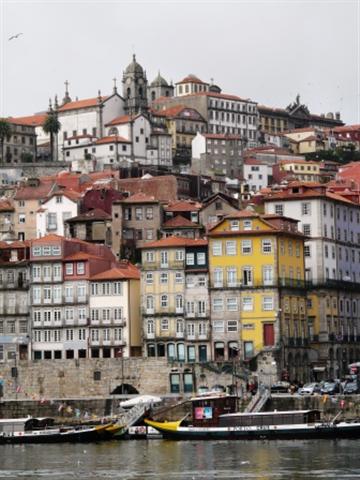
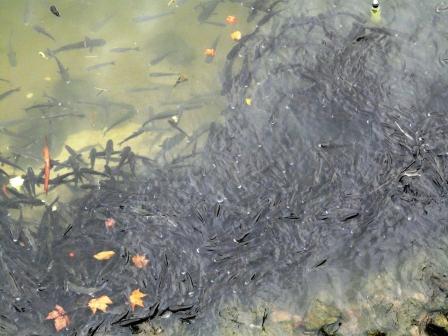
The river itself was teaming with fish. At one drain outlet there were so many of them that you couldn't tell water from fish.
It is crossed by six bridges and on Sunday morning we visited the art gallery (its free on a Sunday) which had an exhibition about Porto's history and the importance of the different river crossings in forming that history.
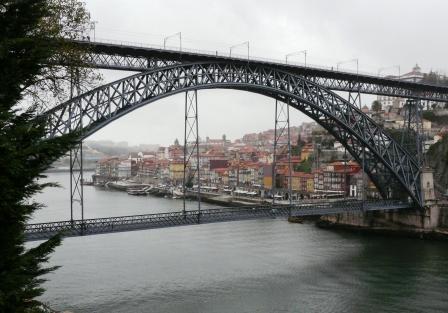
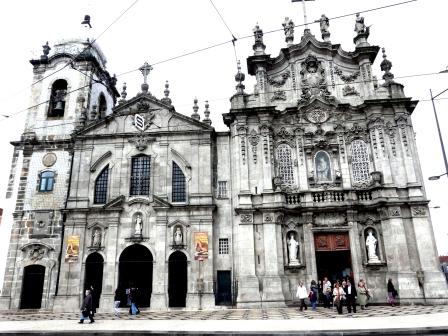
In the evening we took the opportunity of visiting one of the Port Wine lodges to be educated about the different types of port. We rolled home.
Whilst we were enjoying Porto, we were also struggling with trying to facilitate travel to Spain to take up a possible house sitting opportunity. The day we arrived we had an email alert about the prospect, which was to sit a house for four months near Lubrin, near Almeria, Spain. We couldn't believe the coincidence as this was the place we had holidayed with our friends, Phil and Krystyna at the old Cortijo, El Modrano. In fact the guy who posted the advert knew El Modrano and it seemed to us that this was an ideal opportunity. We committed to make arrangements to get there asap.
We had already planned to travel to Lisbon with our bikes, by bus or train as we suspected that the journey by road out of Porto and down the coast would be a difficult one. The train authorities said we would have to try on the day and check with the local station before we bought the ticket and even then the bike would have to be in a bag, but there was no charge The Renex bus station told us that we could take our bikes, provided the bus trunk wasn't full with luggage, but there was a charge for the bikes of euros 9.40 each. We also had to enquire at bike shops about bags in case we couldn't take the bikes as they were. Finally we opted to catch the bus at 13-00, (the least busy time).
Whilst we were looking into bus times we also passed what is the thinnest house in Portugal, which existed apparently due to an obscure law in the past that said two churches could not share a common wall. the house is the bit in the middle, with a single doorway. Apparently it is (or has) been lived in.
Valenca to Tavira - Day 4 - Lisbon
In the morning we took the Metro down to the Placa de Commercial to find the Turismo. On the way we spotted a bike shop called "Without Stress" so Steve called in to buy some new cycling glasses having broken his a few days before. Whilst there we took the opportunity to talk with shop staff about the best way out of Lisbon for our departure and built up a good rapport with the guy running the shop, Bruno.
However, the prospect of our house sitting assignment in Spain was paramount and we spent all day Tuesday finding out how we would get us, our luggage and our bikes to Almeria. The main problem that we had was trying to find free internet access in Lisbon. The local WiFi provider seemed to have tied up all of the hotels and cafes etc with a third party, paid for service and when we tried to buy time on it we couldn't get into the system.
After a fruitless foot aching search we stopped at a café for a coffee. The coffee was awful and we were both in bad moods. When the bill arrived at 6.80 euros Steve was livid and complained to the waiter, ultimately raising it to the manager's attention. Despite Steve pointing out that the coffee was "sh**" and way over priced the owner would have none of it and gave us nothing.
Anger vented, we had to resort to using Western Union for internet access. We were amazed at the large number of Africans that live in Lisbon, using the Western Union to send money or simply to call home.
We spent a lot of shoe leather and got full value from our Metro day pass going to train and bus stations, only to find that neither would provide what we needed to get us and our bikes to Spain. We even looked at shipping the bikes, but that was also prohibitively expensive and would have required boxing the bikes. Eventually we reserved two hire cars from Europcar: one to travel to Vila Real on the Portugal / Spain border and then, having crossed the river with bikes on the ferry into Spain, a second car to travel from Ayamonte to Almeria.
Everything sorted, we arrived back at the hostel exhausted and sent an email to the property owner to tell him everything was in place. Within minutes he called back to tell us that the plan was off. The people currently managing the place wanted to stay on so we were not needed any more.
To drown our sorrows we found an Indian restaurant and had the first curry since leaving the UK. It was so good.
The following day, as we had no jobs to do we put our Valenca to Tavira ride on hold and took the day to go sightseeing. We bought the Lisbon all day Viva pass, which gives unlimited travel on bus, Metro, tram and local ferries.
We started with the Cathedral, the Castle and assorted churches...
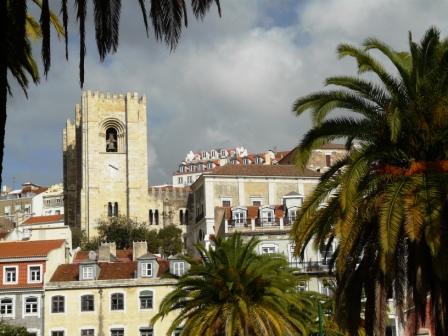
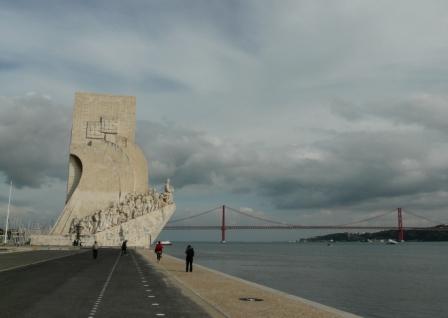
...and then took the tram down to the Belem area on the river front where we saw the monument to Henry the Navigator, the Belem tower and the stunning monastery.
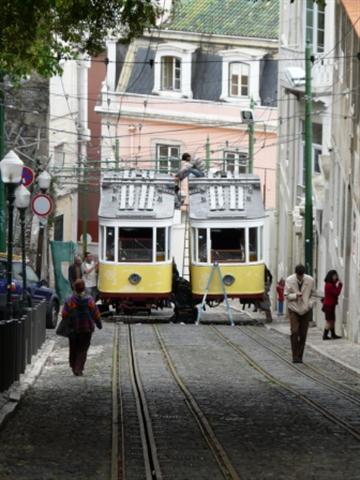
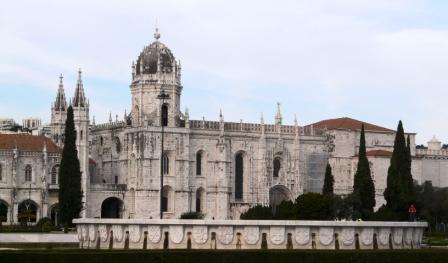
On the way back to catch the tram we stumbled across the amazing and famous Belem pastelaria, a traditional Portuguese tea shop. This place is a must. It spreads over several rooms of blue tiled walls, waiters in black and white and the most delicious cakes and pastries. It also serves Port wine. Considering that it is such a tourist attraction, we were surprised that the prices were reasonable.
After all of this we were bushed, and we headed back to the hotel for dinner at a nice little restaurant almost next door, that served a menu which was more cosmopolitan and a change from the usual traditional Portuguese fare. We were the only customers so we could chat to the waiter and the owner who both spoke good English and were very interested in our Valenca to Tavira ride.
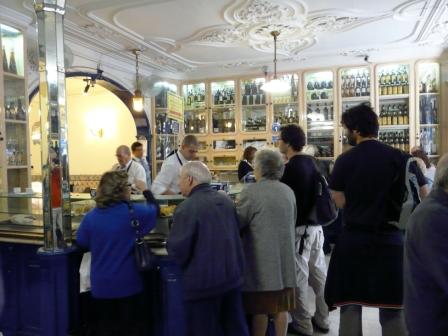
The next day, we woke early to continue our Valenca to Tavira ride, excited that we were back on the bikes again. We packed quickly and headed off to follow a part of our Valenca to Tavira route that we had researched the day before, taking us down back roads to avoid the major traffic routes. The Valenca to Tavira route was easy and downhill all the way. However, fate was due to strike again.
Steve had been concerned about a "pulsing" feeling on his back brake for a while, but it seemed to be getting worse. He stopped to investigate further and found that the wheel rim had a split in it and was very dangerous. We couldn't continue on our journey without getting it fixed.
Fortunately we had to go right passed the same bike shop that we had been in the day before to get to the ferry, so we continued into the town and stopped for a coffee while we waited for the shop to open.
Bruno was very helpful and whilst we waited for advice from the MD at Thorn bikes, he was looking into new wheel rims. Robin rang us from Thorn and suggested that we swop the front wheel rim to the back and then just buy a new wheel for the front.
We had to get Steve's bike up to their other shop in the North of Lisbon. This meant going back to the pension with all of our gear, checking in for another night and then getting the bike onto the Metro to go to the shop. Bikes aren't actually allowed on the Metro until after 8-00pm, but the official relented and let us on. However, we did get told off at the other end as we left the station.
The technician at the shop was also called Bruno and he "pulled out all the stops" rebuilding Steve's wheel as well as cleaning and polishing the whole bike. We collected it at 7-00pm , went back to the hotel and to the same restaurant that we had eaten in last night, to their great surprise as they thought we had left already.
So I would just like to say "Thanks Bruno and all your staff for helping us out of a hole. You did a great job!" www.biclas.com
Valenca to Tavira - Day 5 - Lisbon to Montemor
- Distance 73.8km
- Max Elevation 250m

Valenca to Tavira - Lisbon to Montemor Ride Profile
Ride Description
We repeated the previous morning, this time without hiccoughs. We caught the fast boat over the river Boa to Montijo and having done some lunch shopping in the town our Valenca to Tavira route took us out on the main road towards Montemor. The Valenca to Tavira route was on a road that was of good quality with a wide hard shoulder. It was straight and flat, but reasonably busy.
The first notable thing was that we were now into cork growing country and the Valenca to Tavira route led us through acre after acre of cork plantation. There were a lot of storks, their nests perched high on the telegraph posts.
Wherever there were cattle or sheep there were egrets, perched on their backs, presumably picking out ticks or flies. We passed herds of black and brown bulls with fiery temperaments, possibly bred for fighting.
As we moved further inland, there were more small vine yards and strange dome shaped terracotta pots, perhaps 20 meters in diameter, that looked like large bosoms. We later learned that these were the traditional containers used to hold the fermenting wine, instead of barrels.
At one point we were riding passed a herd of sheep on a section of unfenced road, when suddenly out of the undergrowth burst an alsation dog bounding after the sheep, quickly pursued by, apparently, a shepherd shouting at the top of his voice. We didn't know whether he was trying to stop the dog or stop the sheep, but it certainly didn't appear like the sedate "one man and his dog" that we are used to. We arrived in Montemor after a long and fairly easy ride across the plains, but nonetheless we were still tired. The turismo helped us to find cheap and clean accommodation and also recommended a good restaurant, which was confirmed by the Rough Guide.
Before dinner we went to a local bar for a beer and got into conversation with a gentleman and his wife who were travelling back from his home town to Lisbon where he lived most of the time. He educated us about the horse festival, which was showing on the television news. It is visited by thousands of people each year and looked to be a really great event. Unfortunately it was to the north and not on our Valenca to Tavira route. He also recommended that we should not miss the chance to visit the fortified, medieval hill top town of Monsaraz, and invited us to visit his home town, Vila de Frades in early December for their own "new wine" festival. He explained that in this region they use the traditional method going back to biblical times, of fermenting wine in earthenware pots called Talha.
We went to eat at a restaurant across the road from our accommodation whose name was "8th of March" (the local patron saint's day). We had octopus rice, which was really good and an expensive bottle of local wine at 6 euros. It was the best wine we had sampled in Portugal. Towards the end of the meal our hostess presented us with a plate of what looked like bits of deep fried meat, which was a local speciality. She tried to explain that it was something to do with the innards of the pig. Exasperated she returned from the kitchen with a sample of the raw material. It was in fact the connective tissue from around the intestines. Karen thought it was very tasty, but Steve was not impressed.
After dinner we walked over to one of the squares where the townsfolk were having their annual "New Wine" festival. This new wine was not a nice smooth wine, but rather coarse and raw. However we joined in and downed a glass full along with a bag of roast chestnuts, as we stood by the roaring bonfire listening to the local merengue band and watched the dancing.
Valenca to Tavira - Day 6 - Montemor to Evora
- Distance 39.5km
- Max Elevation 368m
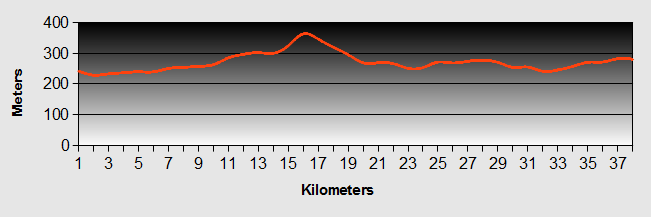
Valenca to Tavira - Montemor to Evora Ride Profile
Ride Description
We had to get an early start on our Valenca to Tavira ride today as we had some serious sight-seeing to get through. We bought water at a local store and then ate breakfast at a café, with two huge "doorsteps" of toast. We shopped at our favourite Portuguese supermarket, Pingo Doce, on outskirts of town and then continued over the plain, which became increasingly undulating. There was little wind and it was easy riding, paralleling the motorway for much of the Valenca to Tavira route.
A few kilometers from Evora we took a detour, to Guadaloup and then onto a sandy rough track for about 4 kilometers uphill. Karen had insisted on seeing the Almedres stone circle, but was suffering from a painful knee. Despite this she soldiered on under these difficult conditions. The circle comprised some 100+ rounded boulders and differed substantially from the more well defined, squared off type rocks that make up many of the stone circles that we had seen in Scotland. From the circle we had a lovely view of Evora in the distance, but the haze prevented worthwhile photographs. We sat in the sunshine and ate lunch.
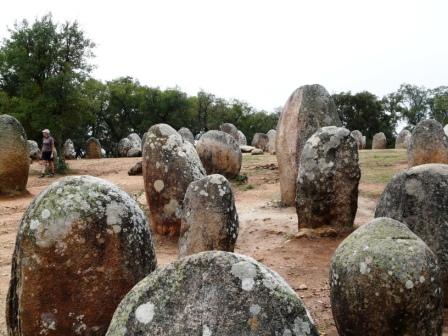
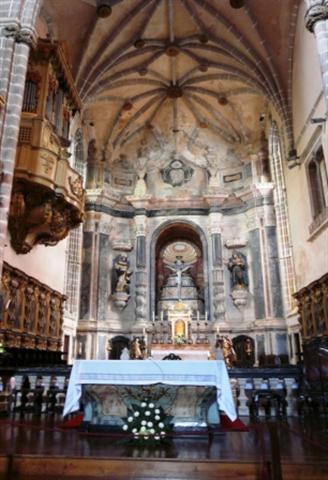
From there, we pedalled back down the track, realising only then how much we had climbed in the first place. We rejoined the main road and our Valenca to Tavira route headed into Evora.
The initial view of Evora is disappointing, until you reach the city walls, which surround the old town. Cycling into town is hard, up cobbled streets. We used the Rough Guide to find economical accommodation, run by a lovely old lady, which we checked into for a couple of nights.
The following day we explored the town visiting the Cathedral...
.... and the bizarre and macabre chapel of bones, adjoining the church of San Francisco.
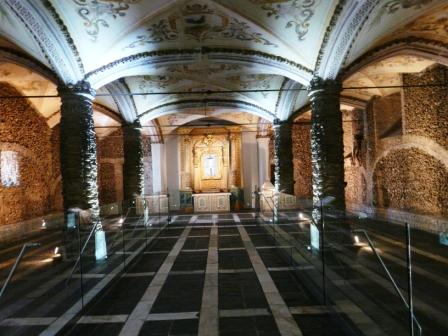
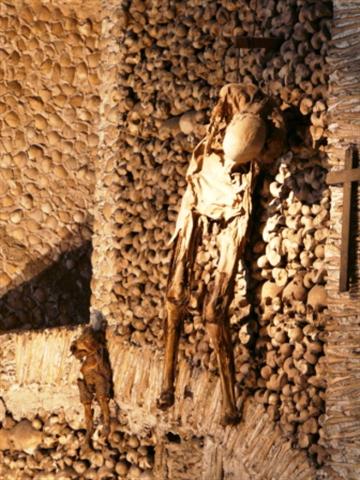
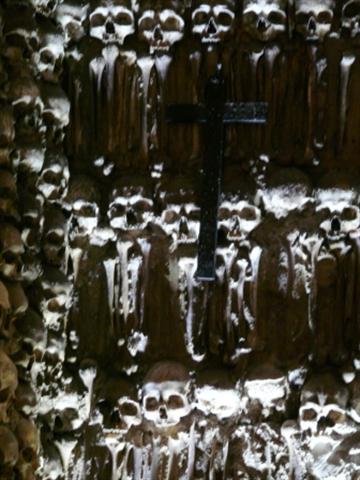
We decided against eating in the tres expensive Pousada and settled for sitting in the square in front of the Roman Temple......
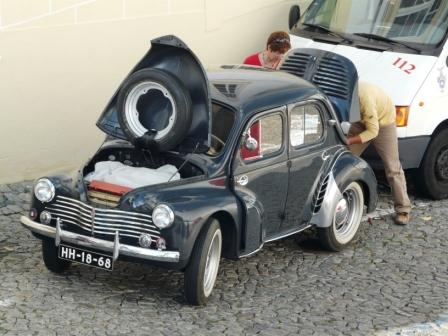
We also took a walk to the municipal gardens where there is a reconstruction of the buildings where Vasco de Gama is said to have received his commission to find a sea route to India.
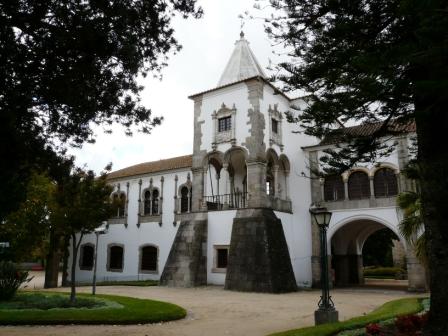
The final, fascinating, point of note was the Roman aqueduct where the local populace had built houses within its arches and which are still lived in today.
Evora is an enchanting town and well worth a visit.
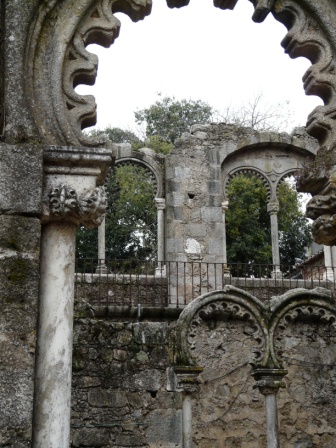
Valenca to Tavira - Day 7 - Evora to Monsaraz
- Distance 56.1 km
- Max Elevation 320 m

Valenca to Tavira - Evora to Monsaraz Ride Profile
Ride Description
We woke to a grey and cloudy sky with a strong wind, which as Murphy's Law dictates, would be in our faces. We set off on our Valenca to Tavira ride without breakfast, hoping to find a cheap supermarket on the way out of town, but we were unlucky and in fear of finding nothing else, we stopped at a garage and brought petrol for the stove and water.
The Valenca to Tavira route was straight and flat through featureless countryside, just cereal fields as far as the eye could see and little signs of habitation, let alone cafes. After about 15km, we passed a road side font which had a large perimeter wall and a circular cattle watering trough. We took shelter from the strong wind while we ate breakfast. It was not the nicest of stops as it was obviously used as a toilet and in the waste bin there were rabbit remains. As we had not been able to shop we ate what we had in our tuck boxes and quickly got back on the move.
After about 25km of the Valenca to Tavira route, the countryside became more interesting. It was undulating with boulder strewn pastures dotted with pine and olive trees. The wind did not abate continuing to blow straight in our faces slowing our progress.
Our Valenca to Tavira route took us through the town Reguengos de Monsaraz, stopping briefly to look at the church, which was untypical of others in the region and came out into the countryside gaining our first view of Monsaraz, standing remote and proud on top of the hill.
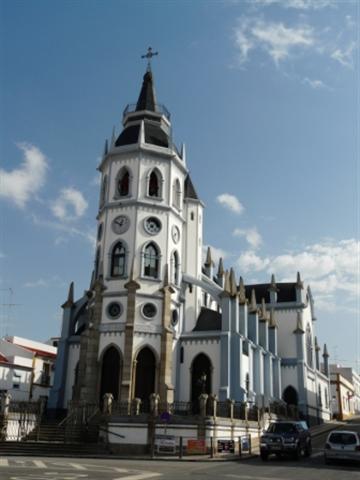
As we drew closer we could appreciate the full spectacle of Monsaraz; the castle on the right hand side, its walls stretching the length of the town and surrounding the white washed houses.
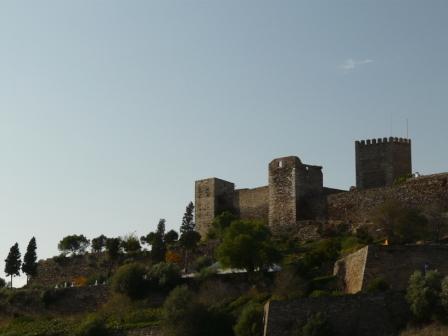
The Valenca to Tavira route takes you around the back of the town and up a steep hill to a viewpoint where we stopped to look out over the Alqueva Reservoir, which seemed to fill every valley as far as the eye could see, right up to the border and beyond into Spain.
This controversial project produced the largest mad-made lake in Europe and provides valuable drinking and irrigation water to this arid region as well as bringing in new tourism to the area.
Due to the strong wind our stop at the viewpoint was brief and we continued up the hill into the small town, through the gate. The town has two narrow, parallel streets, paved in slate and traditional white washed buildings. Apart from resident's vehicles, no cars are allowed in the town and it is a delightful place to wander round.
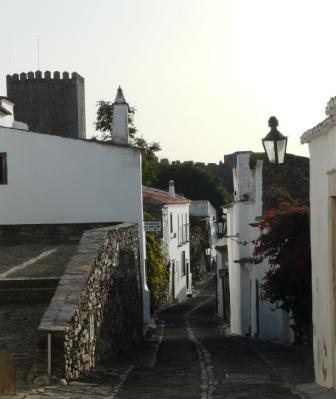
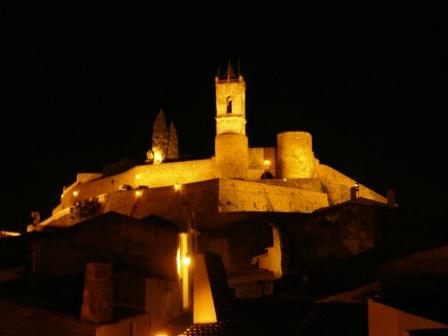
We found the tourist office and met a Canadian couple, Ted and Elaine, who were staying at the very nice Estagem Inn just outside the town walls. They invited us for a drink of wine before dinner and we were enchanted by their rooms which had a great view of the town from the rooftop terrace.
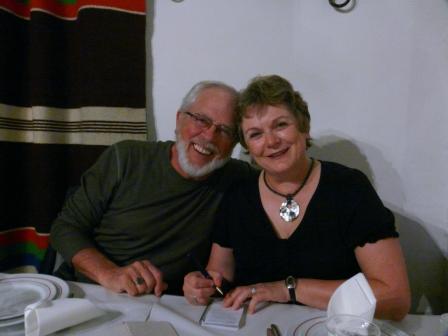
Later we enjoyed a meal with them at a local restaurant. It was nice to have other English speaking people of a similar mind to laugh and joke with.

We found a less expensive village house which had a nice little courtyard at the back, overlooking the plains below. It was very peaceful and quite. We had the best night's sleep we had for a long time.
Valenca to Tavira - Day 8 - Monsaraz to Moura
- Distance 69.2km
- Max Elevation m

Valenca to Tavira - Monsaraz to Moura Ride Profile
Ride Description
For the first time for weeks our accommodation included breakfast. Not a particularly early start and a nice leisurely breakfast.
We left town and stopped at the viewpoint, where we bumped into Ted and Elaine again who were just heading off to Lisbon. By now the wind had dropped and the view was much better. So, a quick photo opportunity a good bye to them and it was down hill; all the way to the long bridge over the reservoir and up the hill to Mourao.
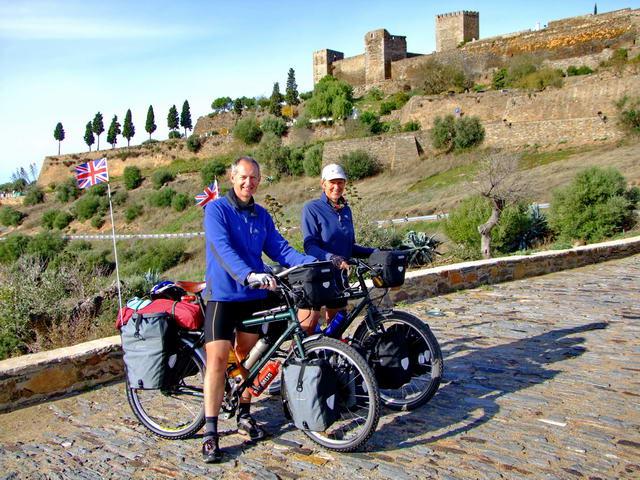
We stopped to look at the castle, which was in a very bad state of repair and disappointing. We bought some lovely meat pies and bread and headed out again on the way south to Moura on the eastern side of the reservoir.
We were into olive growing country with miles of olive trees. They looked lovely with the new green grass which was sprouting following the recent rain. As our Valenca to Tavira ride continued we noticed an intensification of the olive farming with irrigation producing much larger, heavier, crops which bent the branches of the trees down to the ground. The harvesting process however appeared to be the age old method of beating hell out of the tree with a stout stick and collecting the olives on sheets spread underneath.
Our Valenca to Tavira ride continued along the road by the side of the reservoir and stopped on the shore for our lunch. It was the hottest day we'd had in Portugal, with the temperature up to about 24C..
We continued to Moura and found a room in a hotel which was recommended in the Rough Guide. We also had a lovely traditional meal of sea bream and macaroni in a local restaurant, again mentioned in the guide.
Valenca to Tavira - Day 9 - Moura to Mertola
- Distance 87.2km
- Max Elevation 230m

Valenca to Tavira - Moura to Mertola Ride Profile
Ride Description
The hotel was quite noisy during the night, so what should have been a good night's sleep wasn't.
We followed the hotel proprietor's directions and our Valenca to Tavira route took us straight out of town and eventually onto quite roads again. The terrain was slightly hillier and we got back into the subsistence farming type areas, away from the intensive agriculture of the day before. It was a day of hills and vales. None of them too steep or too long, but there were just a lot of them.
We had agonized over which way to go on our Valenca to Tavira route today. It was either a short journey to Serpa or continue on to Mertola. As we had an early start we made good time and arrived in Serpa before lunch. We had a coffee (and cake of course) and then circled around the town finding a shop to buy water and bread for lunch.
You would be forgiven for thinking that there is not much about the towns we are passing through, as we have hardly mentioned them. In fact they have all been lovely little towns, with cobbled streets, castles, churches, whitewashed houses etc, but having been through so many we are a bit "white washed" out.
The day was warm and sunny and after a short while, just passed Espirito Santo, we stopped at the side of the road to eat lunch.
Our Valenca to Tavira route pushed us on through the heat of the afternoon. Steve was complaining of a sore throat and was drinking lots of water. We had been looking for a shop or bar most of the afternoon to get hold of more water. Eventually we reached Mina de Sao Domingos. We ignored the first bar, which was full of men and carried on to the next bar which, much to Karen's delight was full of old women.
As Steve got of his trusty steed he said "If I get mentally undressed as I walk in, I am walking straight out again". Guess what, they did, but the need for coffee and water was too strong to deter him. I think there was also a hint of enjoying it as well!
This small town had been a center for copper mining. Up until the Second World War, the mines were run by an English company that employed a private security firm which treated the workers very badly. The mines continued to operate until 1965.
The town lies on the Baragem de Tosada Grande (reservoir) which we saw as we left. There was a nice little beach there, but we didn't have time to stop. The climb out of the town was quite long and hot. Eventually we reached a bit of a plateau and then it developed into a long and thrilling downhill all the way into the Guardiana Gorge, with Mertola standing above it on the hillside.
The view up and down the gorge was stunning, particularly in the cold morning as the mist was still rising and before the sun had fully risen.
Mertola was a very nice busy town that has been well developed for tourism, but retains its old world charm. There are Roman ruins, a castle, the usual churches and for the adventure minded, kayaking on the river.
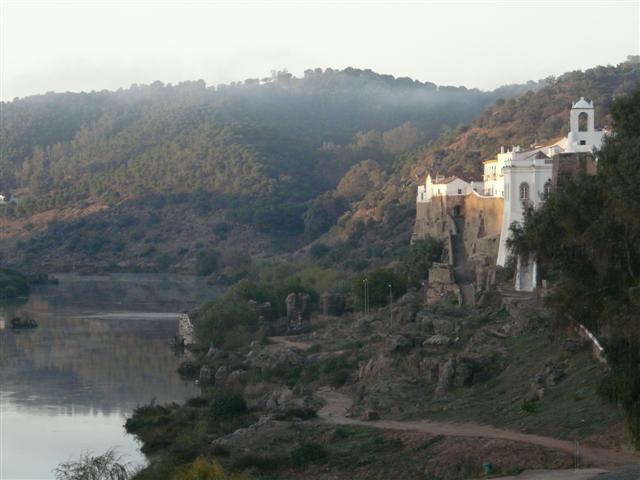
Valenca to Tavira - Day 10 - Mertola to Beliche Reservoir
- Distance 58.5km
- Max Elevation 230m

Valenca to Tavira - Mertola to Beliche Reservoir Ride Profile
Ride Description
The following day we were less certain about our destination for the day. Initially we had planned our Valenca to Tavira route to take us west to Cachopo along minor roads, but we had real difficulty trying to find out if there was any type of accommodation there at all. We also knew that the area was very hilly.
The other option was to go east to Alcoutim, on the border with Spain where we thought there was a youth hostel. Karen had lost her faith in Portuguese youth hostels after Evora where we arrived planning to stay there and found it had been closed down 2 years ago, even though it was on the 2009 guide as well as the web site.
However, before we left we wanted to see little more of Mertola. After a quick look at the Castle and the Roman Ruins we did a bit of shopping in case we had to wild camp that night and then we set off on our Valenca to Tavira route again,along the main road towards Vila Real.
Although our Valenca to Tavira route was on a main road it was not very busy. It was quite a climb out of the town, up some 200 meters, but then got easier. There was little in the way of habitation, let alone cafes so we stopped at the first turn off to Alcoutim for our lunch.
Karen was concerned that by going to Alcoutim we would leave ourselves with a long ride the following day, so we decided to keep going to the next possible habitation at Odeleite. The Valenca to Tavira route took us over three or four major ravines. We were thankful that we were on the main road with its high bridges rather than following the lesser roads into the depths of the valleys.
Eventually we got to Odeleite, but there were just two cafes and no accommodation. We asked where the nearest accommodation was and were told either Alcoutim or Vila Real. Curses! We didn't want to go back to Alcoutim and Vila Real was too far. It was getting towards dusk so we modified our Valenca to Tavira route and cut off the main road to try to find somewhere to camp. After spending all day in lonely country, suddenly there were houses everywhere, all with a large and loud dog. We hunted around for about 30 minutes before we found a spot in the middle of a pine nursery overlooking the villages below and close to the Beliche Reservoir.
We pitched and had a scratch meal of sardines, rice and tomatoes and then emptied our tuck boxes of their few meager contents: a few squares of chocolate, some muesli bars and some cheese and biscuits.
The sun set and we were left with a biblical scene, the sky fading from bright blue to orange at the horizon and a new moon in the sky. By the time we had finished our dinner the sky was dark and filled with billions of stars. We looked in wonder and awe. It was getting cold and the mozzies were extremely hungry. Needless to say we had an early night. We read our books for a short while and tried to get some sleep whilst we listened to the baying of distant dogs.
By now however, Steve's sore throat and cold were getting worse and he didn't sleep well.
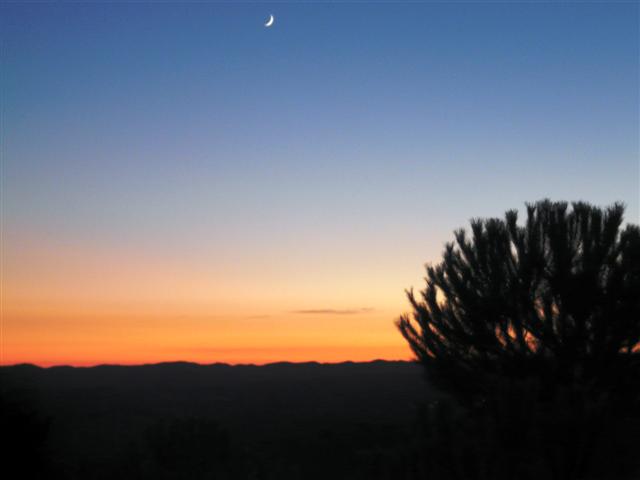
Valenca to Tavira - Day 11 - Beliche to Tavira
- Distance 43.4km
- Max Elevation 150m

Valenca to Tavira - Beliche to Tavira Ride Profile
Ride Description
When you wild camp it's a good idea to be up early and away from your site. Today was no exception. We dressed and breakfasted on the last of our porridge that we had brought from the UK, decamped and set off on our Valenca to Tavira ride along the lovely, quite country roads through the hills for the last part of our journey to South Portugal.
It was a quite crisp morning, but before long the sun was up and our spirits lifted. We enjoyed the ride and managed to navigate our way through the back roads, travelling more or less parallel to the motorway from Vila Real west along the Algarve coast.
With a little help from a dutch guy on a bike who corrected us at one point, we eventually completed our Valenca to Tavira ride, along a pleasant flat road taking us all the way into town.
After exactly 12 weeks and 3500km we had cycled from Inverness, through Spain and from Portugal's north, Valenca to Tavira. We were ready for a rest and Tavira was the place we had chosen to stay for a couple of months.
Our ride from Valenca to Tavira was over and all we had to do now was find somewhere to live!
New! Comments
Have your say about what you just read! Leave me a comment in the box below.